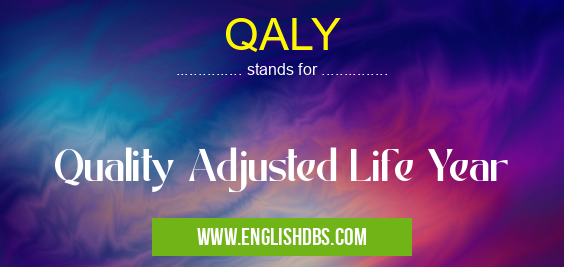What does QALY mean in UNIT MEASURES
Quality Adjusted Life Year (QALY) is an acronym used in the health science and medical field to measure a person's quality of life. It is used for comparing different treatments or interventions that are aimed at improving Quality of Life (QoL). It is also used to determine how much a particular treatment should be funded by healthcare plans and organizations. Its main function is to measure the length and quality of life gained from a medical intervention. The QALY takes into consideration all the factors involved in a person’s overall QoL such as physical, psychological, social and financial well-being. By considering all these factors, it makes decisions about the cost-effectiveness of various treatments more accurate.

QALY meaning in Unit Measures in Miscellaneous
QALY mostly used in an acronym Unit Measures in Category Miscellaneous that means Quality Adjusted Life Year
Shorthand: QALY,
Full Form: Quality Adjusted Life Year
For more information of "Quality Adjusted Life Year", see the section below.
What does QALY mean?
QALY stands for Quality Adjusted Life Year, which is a unit of measurement used to evaluate the quality and length of life gained by people through medical interventions or treatments. QALYs are calculated using data from surveys that measure patients' self-reported symptoms and other aspects of their quality of life which are then analyzed to generate a score between 0 and 1 (1 being perfect health). A higher score indicates better health outcomes, while lower scores indicate poorer outcomes. The score can be adjusted according to different factors such as age, gender, type of treatment received etc., so that health professionals can make informed decisions about how to best allocate resources.
Essential Questions and Answers on Quality Adjusted Life Year in "MISCELLANEOUS»UNITMEASURES"
What is a Quality Adjusted Life Year (QALY)?
A QALY is a measure of health that quantifies the value of one year of life in full health. It's an important metric for measuring the impact of healthcare interventions, comparing different treatments and evaluating cost-effectiveness.
How is QALY calculated?
QALYs are calculated by multiplying the number of years a person will live in full health by a quality score between 0 and 1, where 1 equals perfect health and 0 equals death. This calculation takes into account any effects on quality of life from illness or disability.
What factors are taken into consideration when calculating QALYs?
Factors like age, gender, medical history, lifestyle habits and current health status are all taken into consideration when calculating QALYs. The calculation also takes into account anticipated changes to quality of life due to treatment or intervention effectiveness.
Who uses QALY data?
Quality adjusted life years are used by governments, healthcare providers, economists and pharmaceutical companies to determine which treatments to fund or develop based on cost-effectiveness analyses. In addition, policy makers use this data when deciding how much funding should be allocated for various public health interventions.
What does ‘cost-effectiveness’ mean in terms of QALYs?
Cost-effectiveness refers to how much it costs to produce one additional unit (e.g., year) of full health with a given treatment compared to other available treatments or interventions. When looking at cost-effectiveness in terms of Quality Adjusted Life Years (QALYs), the goal is to maximize total benefit while minimizing total costs for society as a whole over time.
What types of medical interventions can be evaluated with QALYs?
Any type of medical intervention intended to improve patient outcomes can be evaluated using a Quality Adjusted Life Year model. This includes surgical procedures, medication administration, preventive care strategies and lifestyle modifications both within and outside the scope of traditional medicine such as physical activity counseling services or yoga classes offered by community organizations.
How often should updates be made to the QALY calculator?
It's recommended that updates be made to the quality adjusted life years calculator every two years or more frequently if major changes have occurred within the population being studied such as large fluctuations in disease prevalence rates due to new medical advances or changes in population demographics over time.
Are there any ethical concerns associated with using Quality Adjusted Life Years?
Yes there are ethical considerations associated with using Quality Adjusted Life Years as some may interpret it as placing an economic value on human life which can lead to inequitable access if certain individuals are not eligible for therapies due solely based upon their cost effectiveness relative to other populations groups.
Final Words:
The Quality Adjusted Life Year (QALY) is an important tool for measuring the impact of medicines and treatments on people’s quality of life. It helps healthcare professionals make sound decisions about which treatments are most cost effective and beneficial for patients with limited budgets or access to care. Through its use in clinical trials, cost-effectiveness studies, economic evaluations, epidemiological studies and more; it helps ensure that governments allocate resources effectively to provide the best possible services for everyone, regardless of income level or geography.
